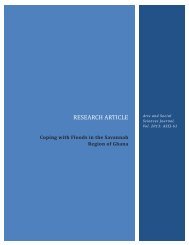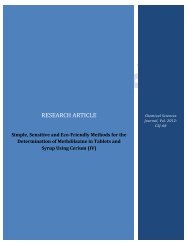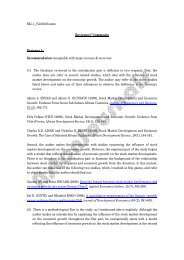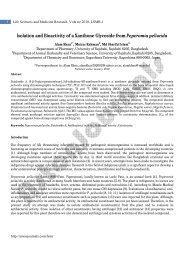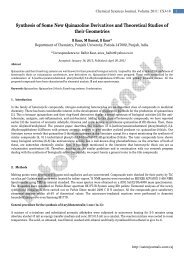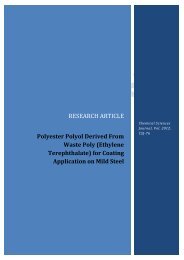An Efficient Synthesis of Biologically Active ... - AstonJournals
An Efficient Synthesis of Biologically Active ... - AstonJournals
An Efficient Synthesis of Biologically Active ... - AstonJournals
You also want an ePaper? Increase the reach of your titles
YUMPU automatically turns print PDFs into web optimized ePapers that Google loves.
RESEARCH ARTICLEChemical SciencesJournal, Vol. 2012:CSJ-87<strong>An</strong> <strong>Efficient</strong> <strong>Synthesis</strong> <strong>of</strong> <strong>Biologically</strong> <strong>Active</strong>Tetrachloroquinazolin-2,4-dione
Chemical Sciences Journal, Vol. 2012: CSJ-873Cl O.ClNCH 3Cl N O H.ClHm/z312 (38.05%)m/z314 (M2) (49.18%)CH 3N C OCl.ClOClNHClm/z255 (78.61%)m/z257 (M2) (100%)ClClCl OCHN 2N OHClm/z311 (1.0%)ClClHNCO.COClClClNH.ClClClm/z227 (6.55%)m/z212 (2.33%)Scheme 1: The main fragmentations for compound 2a.2.3.6. 3-Benzyl(1H,3H)tetrachloroquinazolin-2,4-dione (2f)White crystal (0.24 gm, 76%), m.p. 262–2638C. FT-IR (KBr, cm 21 ): 3211 (NH), 3032 (CH arom.), 1721, 1658(C5O’s). 1 H NMR spectrum: (200 MHz, DMSO-d6): 7.2–7.35 (m, 5H, arom.); 5.1 (s, 2H, CH 2); 11.1 (s, 1H, NH).MS (m/z, %): 388 (9.43%) (M 1 ) in addition to the characteristic peaks for compounds containing four chlorine atomsat (M12), (M14) and (M16). <strong>An</strong>al. calcd. for C 15H 8Cl 4N 2O 2: C, 46.20%; H, 2.06%; N, 7.18%. Found: C, 46.32%; H, 2.07%;N, 7.26%.2.3.7. 3-Phenyl(1H,3H)tetrachloroquinazolin-2,4-dione (3a)White crystal (0.22 gm, 68%), m.p. 328–3298C. 1 H NMR spectrum: (300 MHz, DMSO-d6): 7.3–7.5 (m, 5H, arom.); 11.3(s, 1H, NH). MS (m/z, %): 374 (M 1 ) in addition to the characteristic peaks for compounds containing four chlorineatoms at (M12), (M14) and (M16). <strong>An</strong>al. calcd. for C 14H 6Cl 4N 2O 2: C, 44.73%; H, 1.60%; N, 7.45%. Found: C, 44.94%;H, 1.61%; N, 7.56%.2.3.8. 3-Tolyl(1H,3H)tetrachloroquinazolin-2,4-dione (3b)White crystal (0.33 gm, 69%), m.p. 325–3278C. FT-IR (KBr, cm 21 ): 3200 (ν NH), 1740, 1660 (ν C5O’s). 1 H NMRspectrum: (300 MHz, DMSO-d6): 2.2 (s, 3H, CH 3); 7.1–7.3 (2d, 4H,A 2B 2arom.); coupling constant for aromatic protons5 0.0005 Hz,11.2 (s, 1H, NH). MS (m/z, %): 388 (M 1 ) in addition to the characteristic peaks for compoundscontaining four chlorine atoms at (M12), (M14) and (M16). <strong>An</strong>al. calcd. for C 15H 8Cl 4N 2O 2: C, 46.20%; H, 2.06%;N, 7.18%. Found: C, 46.41%; H, 2.07%; N, 7.21%.http://astonjournals.com/csj
4 Research Article2.3.9. 3-Hydroxyphenyl(1H,3H)tetrachloroquinazolin-2,4-dione (3c)Grey crystal (0.45 gm, 81%), m.p. 308–3098C. FT-IR (KBr, cm 21 ): 3472 (ν OH), 3200 (ν NH), 1726, 1664 (ν C5O’s).1H NMR spectrum: (300 MHz, DMSO-d6): 6.8–7.1 (2d, 4H, A 2B 2arom.); 9.65 (s, 1H, OH); coupling constant for aromaticprotons 5 0.0008 Hz, 11.2 (s, 1H, NH). MS (m/z, %): 390 (M 1 ) in addition to the characteristic peaks forcompounds containing four chlorine atoms at (M12), (M14) and (M16). <strong>An</strong>al. calcd. for C 14H 6Cl 4N 2O 3: C, 42.90%;H, 1.54%; N, 7.14%. Found: C, 43.02%; H, 1.55%; N, 7.17%.2.3.10. 3-<strong>An</strong>isidyl(1H,3 H)tetrachloroquinazolin-2,4-dione (3d)Buff crystal (0.49 gm, 83%), m.p. 312–3148C. FT-IR (KBr, cm 21 ): 3196 (ν NH), 3001 (ν CH arom.), 2227 (ν CH aliph.),1746, 1669 (ν C5O’s). 1 H NMR spectrum: (300 MHz, DMSO-d6): 3.8 (s, 3H, OCH 3); 7.0–7.24 (2d, 4H,A 2B 2arom.);coupling constant for aromatic protons 5 0.00077 Hz, 11.2 (s, 1H, NH). MS (m/z, %): 404 (M 1 ) in addition to thecharacteristic peaks for compounds containing four chlorine atoms at (M12), (M14) and (M16). <strong>An</strong>al. calcd. forC 15H 8Cl 4N 2O 3: C, 44.37%; H, 1.99%; N, 6.90%. Found: C, 44.62%; H, 2.01%; N, 7.00%.2.3.11. 3-Chlorophenyl(1H,3H)tetrachloroquinazolin-2,4-dione (3e)White crystal (0.55 gm, 67%), m.p. 320–3228C. 1 H NMR spectrum: (300 MHz, DMSO-d6): 7.3–7.6 (2d, 4H,A 2B 2arom.); coupling constant for aromatic protons 5 0.00088 Hz, 11.3 (s, 1H, NH). MS (m/z, %): 408 (M 1 ) in additionto the characteristic peaks for compounds containing four chlorine atoms at (M12), (M14) and (M16). <strong>An</strong>al.calcd. for C 14H 5Cl 5N 2O 2: C, 40.98%; H, 1.23%; N, 6.82%. Found: C, 41.16%; H, 1.24%; N, 6.95%.2.3.12. 3-Acetophenyl(1H,3H)tetrachloroquinazolin-2,4-dione (3f)Yellow crystal (0.3 gm, 65%), m.p. 210–2128C. FT-IR (KBr, cm 21 ): 3231 (ν NH), 3057 (ν CH arom.), 2919 (ν CHaliph.), 1740, 1660 (ν C5O’s). 1 H NMR spectrum: (200 MHz, DMSO-d6): 2.6 (s, 3H, CH 3); 7.5–8.1(2d, 4H, A 2B 2arom.);coupling constant for aromatic protons 5 0.0031 Hz, 11.4 (s, 1H, NH). MS (m/z, %): 416 (M 1 ) in addition to thecharacteristic peaks for compounds containing four chlorine atoms at (M12), (M14) and (M16). <strong>An</strong>al. calcd. forC 16H 8Cl 4N 2O 3: C, 45.98%; H, 1.92%; N, 6.70%. Found: C, 46.35%; H, 1.94%; N, 6.92%.2.3.13. 3-Carboxyphenyl(1H,3H)tetrachloroquinazolin-2,4-dione (3g)White crystal (0.29 gm, 72%), m.p. 318–3198C. FT-IR (KBr, cm 21 ): 3395 (ν NH), highly bonded OH extending from3267–2724, 1740, 1660 (ν C5O’s). 1 H NMR spectrum: (200 MHz, DMSO-d6): 7.4–8.1(2d, 4H, A 2B 2arom.); couplingconstant for aromatic protons 5 0.0032 Hz, 11.4 (s, 1H, NH); 12.8 (broad s, 1H, COOH). MS (m/z, %): 418 (M 1 ) inaddition to the characteristic peaks for compounds containing four chlorine atoms at (M12), (M14) and (M16). <strong>An</strong>al.calcd. for C 15H 6Cl 4N 2O 4: C, 42.89%; H, 1.44%; N, 6.67%. Found: C, 43.28%; H, 1.45%; N, 6.98%.2.3.14. 3-Nitrophenyl(1H,3H)tetrachloroquinazolin-2,4-dione (3h)Yellow crystal (0.34 gm, 77%), m.p. 304–3068C. 1 H NMR spectrum: (300 MHz, DMSO-d6): 7.6–8.4 (2d, 4H, A 2B 2arom.);coupling constant for aromatic protons 5 0.0024 Hz, 11.4 (s, 1H, NH). <strong>An</strong>al. calcd. for C 14H 5Cl 4N 3O 4: C, 39.95%; H,1.19%; N, 9.91%. Found: C, 40.03%; H, 1.18%; N, 10.0%.2.3.15. <strong>An</strong>tibacterial studies<strong>An</strong>tibacterial activity was determined against the above-mentioned bacteria using the paper disk assay method [20] withWhatman No. 1 filter paper disk <strong>of</strong> diameter 6 mm, which was sterilized by autoclaving for 15 min at 1218C. The steriledisks were impregnated with different tested compounds (50 mg/ml). Agar plates were surface inoculated uniformly fromthe broth culture <strong>of</strong> the tested microorganisms. In all cases, the concentration was approximately 1.2 3 10 8 CFU/ml[21]. The impregnated disks were placed on the Muller Hinton medium suitably spaced apart, and the plates were incubatedat 378C for 24 h. Dimethylformamide (DMF) was used as negative control, while commercial antibiotic disks (tetracycline,30 mg/disk) were used as a positive control. The diameter <strong>of</strong> the growth inhibition halos caused by differentcompounds tested was measured by a ruler and expressed in millimeter. All the assays were carried out in triplicate.3. Results and Discussion3.1. <strong>Synthesis</strong>The synthesis <strong>of</strong> the compounds 2a–f and 3a–h resulted from three steps [22], sequence starting from tetrachlorophthalicanhydride followed by N-hydroxytetrachlorophthalimide, then N-phenylsulphonyloxytetrachlorophthalimide (1).http://astonjournals.com/csj
8 Research Article4. Biological ActivityBacterial infection causes high rate <strong>of</strong> mortality in human population and aquaculture organisms [23]. For example,B. cereus is responsible for causing foodborne diseases [24]. S. aureus causes diseases such as mastitis, abortion andupper respiratory complications, while Salmonella sp. causes diarrhea and typhoid fever [25]. The revolutionizedtherapy <strong>of</strong> infectious diseases by the use <strong>of</strong> antimicrobial drugs has certain limitations because <strong>of</strong> changing patterns<strong>of</strong> resistance in pathogens and side effects they produced. These limitations demand for improved pharmacokineticproperties, which necessitate continued research for new antimicrobial compounds for the development <strong>of</strong> drugs[26]. So accordingly, pharmaceutical industries are giving importance to the compounds derived from quinazolinedionesources.4.1. Bacterial source and culture conditionsThe bacteria used in this study were S. aureus, S. typhi and B. cereus (obtained from the Pathology Department, Faculty<strong>of</strong> Veterinary Medicine, South Valley University). These bacterial strains were maintained on suitable medium at 48Cand subcultured on Mueller Hinton Broth at 378C for 18 h before testing.4.2. <strong>An</strong>tibacterial assaysMost <strong>of</strong> the tested compounds exhibited antibacterial activity against all the tested bacterial species. The gramnegativeS. typhi was the most sensitive to most <strong>of</strong> the compounds tested (2a–d and 3f). The higher antibacterialactivity (indicated as zone <strong>of</strong> inhibition) was recorded for compound 3f followed by 2d and 2f (11, 10 and 10 mm),respectively (Figure 1). Hence, the susceptibility <strong>of</strong> the gram-positive B. cereus to compounds 2d, 2f, 3a, 3e–g wasmore pronounced when compared to the other tested compounds. The most observed antibacterial activity wasrecorded for compound 2d for both gram-positive and negative bacteria; this may be due to the four chlorine atoms[27] and pyrimidine ring [28–30]. On the other hand, S. aureus and B. cereus were resistant to compounds 2a–c, whilethey were sensitive to the other compounds. It is worthy to mention that the clear zone caused by compounds2a, b and d with S. typhi was nearly closely to the inhibition zone caused by tetracycline disk; the sensitivity <strong>of</strong>these bacteria toward our compounds may be due to the presence <strong>of</strong> four chlorine atoms [27] and pyrimidine ring[28–30] (Figure 1). The efficiency <strong>of</strong> compounds 2a–d, and 3f as antibacterial products recorded the highest inhibitionwith the gram-negative bacteria; while 2d, 2f, 3a, 3e–g were more efficient for gram-positive bacteria. Thus,Figure 1: <strong>An</strong>tibacterial activities <strong>of</strong> quinazoline dione compounds against some gram-positive and negative bacteria.http://astonjournals.com/csj
Chemical Sciences Journal, Vol. 2012: CSJ-879the susceptibility <strong>of</strong> gram-positive bacteria to quinazolinediones was more than those <strong>of</strong> gram-negative bacteria.Many authors recorded similar observations [31]. The greater susceptibility <strong>of</strong> gram-positive bacteria to quinazolinedione compounds was because <strong>of</strong> the differences in their cell wall structure and their composition [32]. In gramnegativebacteria, the outer membrane acts as a barrier to many environmental substances, including antibiotics [33].The presence <strong>of</strong> thick murine layer in the cell wall also prevents the entry <strong>of</strong> the inhibitors [34]. The above resultsconfirm the broad antibacterial effect <strong>of</strong> quinazolinedione compounds.Competing InterestsNone declared.Authors’ ContributionsAll authors contributed equally to this work.AcknowledgementThe authors are grateful to the spirit <strong>of</strong> Pr<strong>of</strong>. Dr. Yousef H. Ebeed, Faculty <strong>of</strong> Science, South Valley University for hisguidance and encouragement.References[1] American Chemical Society, 1989. UNT Digital Library, Division <strong>of</strong> Chemical Information. Chemical Information Bulletin, 41(3).New York: Philadelphia, Pennsylvania.[2] Bakhite EA, Radwan SM, El-deen AMK, 2000. <strong>Synthesis</strong> <strong>of</strong> novel pyridothienopyrimidines, pyridothienopyrimidothiazines,pyridothienopyrimidobenzthiazoles and triazolopyridothienopyrimidines. Journal <strong>of</strong> Chinese Chemical Society, 47(5): 1105.[3] Younes MI, Abbas HH, Metwally SAM, 1999. <strong>Synthesis</strong> <strong>of</strong> ethyl-5-amino-1-(5-ethyl-5H-1,2,4-triazino [5,6-b]indol-3-yl)-1Hpyrazole-4-carboxylateand pyrazolo[3,4-d]pyrimidine derivatives. Pharmazine, 46(2): 98.[4] Rideout JL, Krenitesky TA, Chao EY, Elion GB, Williams RB, Latter VS, 1983. Pyrazolo[3,4-d]pyrimidine ribonucleosides asanticoccidials. 3. <strong>Synthesis</strong> and activity <strong>of</strong> some nucleosides <strong>of</strong> 4-[(arylalkenyl)thio]-pyrazolo[3,4-d]pyrimidines. Journal <strong>of</strong>Medicinal Chemistry, 26(10): 1489.[5] Rideout JL, Krenitesky TA, Koszalka GW, Coln NK, Chao EY, Elion GB, et al., 1982. Pyrazolo[3,4-d]pyrimidine ribonucleosidesas anticoccidials. 2. <strong>Synthesis</strong> and activity <strong>of</strong> some nucleosides <strong>of</strong> 4-(alkylamino)-1H-pyrazolo[3,4-d]pyrimidines. Journal <strong>of</strong>Medicinal Chemistry, 25 (9): 1040.[6] Marie MG, Aly DM, Mishrikey MM, 1992. A new synthesis <strong>of</strong> pyrazolo[1,5-c]pyrimidines from acetylenic β-diketones. Bulletin<strong>of</strong> the Chemical Society <strong>of</strong> Japan, 65(12): 3419.[7] Krenitesky TA, Rideout JL, Koszalka GW, Inmmon RB, Chao EY, Elion GB, 1982. Pyrazolo[3,4-d]pyrimidine ribonucleosidesas anticoccidials. 2. <strong>Synthesis</strong> and activity <strong>of</strong> some nucleosides <strong>of</strong> 4-(alkylamino)-1H-pyrazolo[3,4-d]pyrimidines. Journal <strong>of</strong>Medicinal Chemistry, 25(1): 32.[8] Gatta F, Perotti F, Gradoni L, Gramiccia M, Orsini S, Palazzo G, et al., 1990. <strong>Synthesis</strong> <strong>of</strong> some 1-(dihydroxypropyl)pyrazolo[3,4-d]-pyrimidines and in vivo evaluation <strong>of</strong> their antileishmanial and antitrypanosomal activity. European Journal <strong>of</strong>Medicinal Chemistry, 30: 419.[9] Ugarkar BG, Cottam HB, Mekernan PA, Robins RK, Revankar GR, 1984. <strong>Synthesis</strong> and antiviral/antitumor activities <strong>of</strong> certainpyrazolo[3,4-d]pyrimidine-4(5H)-selone nucleosides and related compounds. Journal <strong>of</strong> Medicinal Chemistry, 27(8): 1026.[10] Makara GM, Ewing W, Winter E, 2001. <strong>Synthesis</strong> <strong>of</strong> bicyclic pyrimidine derivatives as ATP analogues. Journal <strong>of</strong> OrganicChemistry, 66(17): 5783.[11] Mishra B, Muddin N, 1989. A convenient and facile synthesis <strong>of</strong> 1-aroyl-4-oxo-5-substituted-phenylpyrazolo[3,4-d]pyrimidine-6-thiones. Indian Journal <strong>of</strong> Chemistry, 28B: 346.[12] Miller DJ, Shen H, Such JK, Kerwin SM, Robertass JD, 2002. Structure-based design and characterization <strong>of</strong> novel platformsfor ricin and shiga toxin inhibition. Journal <strong>of</strong> Medicinal Chemistry, 45(1): 90.[13] El-Baendary ER, Badria FA, 2000. <strong>Synthesis</strong>, DNA-binding, and antiviral activity <strong>of</strong> certain pyrazolo[3,4-d]pyrimidine derivatives.Archives <strong>of</strong> Pharmacy, 99: 333.[14] Balzarini J, Mc Guingan C, 2002. Bicyclic pyrimidine nucleoside analogues (BCNAs) as highly selective and potent inhibitors<strong>of</strong> varicella-zoster virus replication. Journal <strong>of</strong> <strong>An</strong>timicrobial Chemotherapy, 50: 5.http://astonjournals.com/csj
10 Research Article[15] Shalaby AM, Fathalla OA, Kassem EMM, Zaki MEA, 2000. <strong>Synthesis</strong> <strong>of</strong> new 5-N-pyrazolyl amino acids, pyrazolopyrimidinesand pyrazolopyridines derivatives. Acta Chimica Slovenica, 47: 187.[16] El-Afalek EI, Abubshit SA, 2001. Heterocyclic o-aminonitriles: preparation <strong>of</strong> pyrazolo[3,4-d]-pyrimidines with modification<strong>of</strong> the substituents at the 1-position. Molecules, 6: 621.[17] Bhuyan PJ, Borah HN, Lekhok KC, Sandhu JS, 2001. Studies on uracils: a facile one-pot synthesis <strong>of</strong> pyrazolo[3,4-d]pyrimidines.Journal <strong>of</strong> Heterocyclic Chemistry, 38: 491.[18] Finch RA, Revankar GR, Chen PK, 1996. Structural and functional relationships <strong>of</strong> toyocamycin on NPM-translocation.<strong>An</strong>ticancer Drug Design, 12: 205.[19] Silverstein RM, Bassler GC, Morrill TC, 1916. Spectrometric Identification <strong>of</strong> Organic Compounds. New York: John Wiley, 35.[20] Seeley HW, VanDemark PJ, 1981. Selected Exercises from Microbes in Action: A Laboratory Manual <strong>of</strong> Microbiology, ThirdEdition, USA: W.H. Freeman and Company.[21] Salem WM, Galal H, Nasr El-deen F, 2011. Screening for antibacterial activities in some marine algae from the red sea (Hurghada,Egypt). African Journal <strong>of</strong> Microbiology Research, 5(15): 2160–2167.[22] Hassan MA, Younes AMM, Taha MM, Abdel-Monsef AH, 2012. Action <strong>of</strong> some heterocyclic amines and difunctional nucleophileson N-phenylsulphonyloxytetrachlorophthalimide. Chemistry Journal, 158–165.[23] Kandhasamy M, Arunachalam KD, 2008. Evaluation <strong>of</strong> in vitro antibacterial property <strong>of</strong> seaweeds <strong>of</strong> southeast coast <strong>of</strong> India.African Journal <strong>of</strong> Biotechnology, 7(12): 1958–1961.[24] Kotiranta A, Lounatmaa K, Haapasalo M, 2000. Epidemiology and pathogenesis <strong>of</strong> B. cereus infections. Microbes Infection2(2): 189–198.[25] Kandhasamy M, Arunachalam KD, 2008. Evaluation <strong>of</strong> in vitro antibacterial property <strong>of</strong> seaweeds <strong>of</strong> southeast coast <strong>of</strong> India.African Journal <strong>of</strong> Biotechnology, 7(12): 1958–1961.[26] Al-Haj NA, Mashan NI, Shamsudin MN, 2009. <strong>An</strong>tibacterial activity in marine algae Eucheuma denticulatum against S. aureusand S. pyogenes. Research Journal <strong>of</strong> Biological Sciences, 4(4): 519–524.[27] Ryan KJ, Ray CG, 2004. Sherris Medical Microbiology, Fourth Edition. McGraw Hill. ISBN 0-8385-8529-9.[28] Selassie CD, Li R, Poe M, Hansch C, 1991. On the optimization<strong>of</strong> hydrophobic and hydrophilic substituent interactions <strong>of</strong>2,4-diamino-5-(substituted-benzyl)pyrimidines with dihydr<strong>of</strong>olate reductase. Journal <strong>of</strong> Medicinal Chemistry, 34: 46.[29] Mc Nair-Scott DB, Ulbrich TLV, Rogers ML, Chu E, Rose C, 1959. Effect <strong>of</strong> substituted pyrimidines on growth and biosynthesis<strong>of</strong> microorganisms. Cancer Research, 19: 15.[30] Cheng CC, 1969. 3 some pyrimidines <strong>of</strong> biological and medicinal interest-I. Progress in Medicinal Chemistry, 6: 67.[31] Demirel Z, Yilmaz-Koz FF, Karabay-Yavasoglu UN, Ozdemir G, Sukatar A, 2009. <strong>An</strong>timicrobial and antioxidant activity <strong>of</strong> brownalgae from the Aegean sea. Journal <strong>of</strong> Serbian Chemical Society, 74(6): 619–628.[32] Taskin E, Ozturk M, Taskin E, Kurt O, 2007. <strong>An</strong>tibacterial activities <strong>of</strong> some marine algae from the Aegean sea (Turkey). AfricanJournal <strong>of</strong> Biotechnology, 6(24): 2746–2751.[33] Tortora GJ, Funke BR, Case CL, 2001. Microbiology: <strong>An</strong> Introduction. San Francisco: Benjamin Cummings, 88.[34] Paul John Peter M, Venkatesan M, Yesu Raj J, 2012. The antibacterial activity and phytochemicals <strong>of</strong> the leaves <strong>of</strong> stylosanthesfruticosa. International Journal <strong>of</strong> Phytopharmacy, 2(4): 98–106.http://astonjournals.com/csj


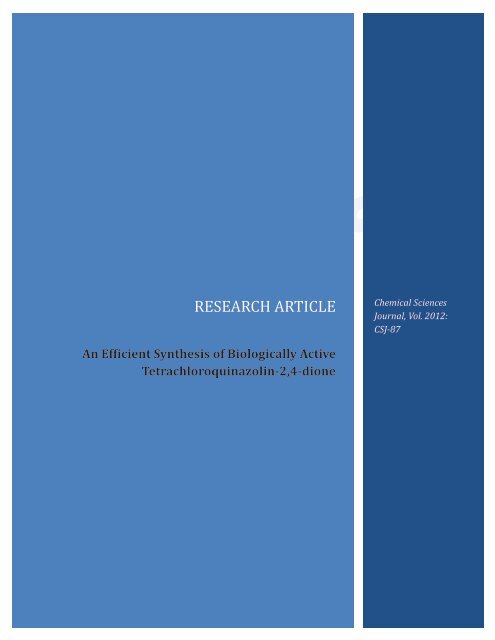
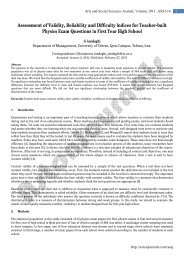
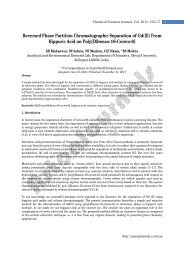
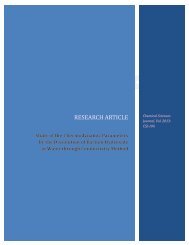
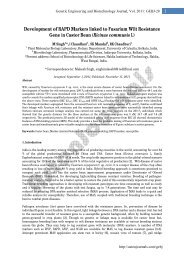

![[1,4]-benzodiazepine-2-one Derivatives as Potent - AstonJournals](https://img.yumpu.com/49117784/1/184x260/14-benzodiazepine-2-one-derivatives-as-potent-astonjournals.jpg?quality=85)
